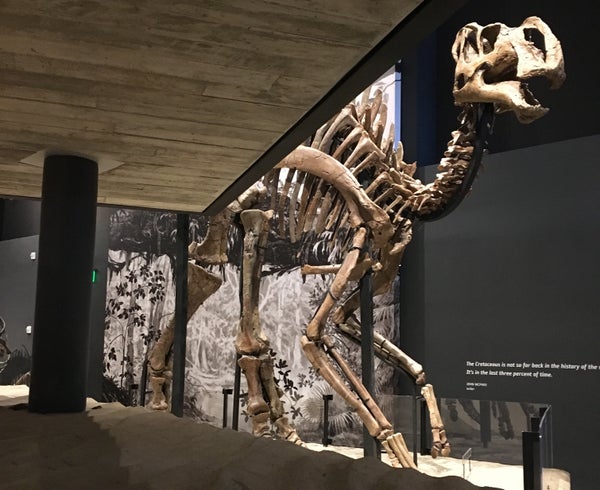This article was published in Scientific American’s former blog network and reflects the views of the author, not necessarily those of Scientific American
There were plenty of good reasons for non-avian dinosaurs to herd together. More eyes meant greater vigilance for predators, and, failing that, the larger the group the smaller a dinosaur's individual chances of being picked out for dinner. Watching over offspring, and finding potential mates, can be easier en masse, too. But there may have been a hidden benefit that helped drive the evolution of gregarious dinosaurs, and it has everything to do with their guts.
“Extant herbivorous vertebrates are not genetically provided with the enzymes needed to break down and metabolize cellulose and other fibrous plant tissues,” paleontologists Marco Romano and James Farlow point out in
a new paper. Modern herbivores get around this problem by becoming “infected” with appropriate gut bacteria, often by ingesting feces of their parents or neighbors. And if this was true of non-avian dinosaurs like the shovel-beaked Maiasaurua and the horned Centrosaurus, then there would have been another good reason for herbivorous dinosaurs to be social.
On supporting science journalism
If you're enjoying this article, consider supporting our award-winning journalism by subscribing. By purchasing a subscription you are helping to ensure the future of impactful stories about the discoveries and ideas shaping our world today.
Romano and Farlow point to sites like Egg Mountain. Dozens of Maiasaura have been found here, from hatchlings all the way up to adults, as well as multiple nests. In a place like this, the researchers propose, the feces of adult Maiasaura that already contained plant-busting bacteria could have been worked into the structure of the nests. Hatchlings could have then accidentally ingested the gut microbes as food was dropped into the nest and even passed the bacteria between each other. Other assemblages where young dinosaurs hung around with adults, like the Centrosaurus bonebeds of Alberta, could also be signs of the need to transfer gut bacteria.
For now, the argument is speculative. We know little of dinosaur digestive systems - mostly revealed to us as gut contents, petrified poop, and other end products of digestion - and the social trend doesn’t seem to be universal. The long-necked sauropods, for example, are thought to have opted for a lay ‘em and leave ‘em strategy with their eggs, like modern sea turtles, where survival of their young was merely a numbers game. Likewise, Triceratops are often found in isolation, with the one reported case of possible sociality being among juveniles. Unless fossils of the plant-dissolving bacteria were preserved and can be identified from fossil gut contents, it may be hard to test this idea.
Yet dinosaurs were real animals, and, like animals alive today, they were actually ecosystems themselves. There must have been dinosaur microbiomes that changed over time just as the dinosaurs themselves did. If we’re to understand dinosaurs at all, then, we have to go beyond flesh and bone. Perhaps future research will uphold what Romano and Farlow propose. Perhaps not. But for now, I can’t help but share their wonder at the possibility. As they write at the conclusion of their proposal, “It is sobering to think that microscopic beneficial bacteria, invisible to the human eye, may have acted as internal pilots driving even the social evolution of titans weighing as much as 80 tons."
